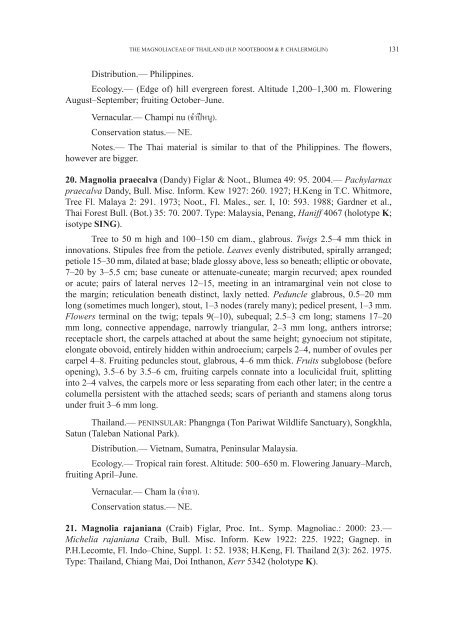You also want an ePaper? Increase the reach of your titles
YUMPU automatically turns print PDFs into web optimized ePapers that Google loves.
THE MAGNOLIACEAE OF <strong>THAI</strong>LAND (H.P. NOOTEBOOM & P. CHALERMGLIN)<br />
Distribution.— Philippines.<br />
Ecology.— (Edge of) hill evergreen forest. Altitude 1,200–1,300 m. Flowering<br />
August–September; fruiting October–June.<br />
Vernacular.— Champi nu (จำปี หนู).<br />
Conservation status.— NE.<br />
Notes.— The Thai material is similar to that of the Philippines. The flowers,<br />
however are bigger.<br />
20. Magnolia praecalva (Dandy) Figlar & Noot., Blumea 49: 95. 2004.— Pachylarnax<br />
praecalva Dandy, Bull. Misc. Inform. Kew 1927: 260. 1927; H.Keng in T.C. Whitmore,<br />
Tree Fl. Malaya 2: 291. 1973; Noot., Fl. Males., ser. I, 10: 593. 1988; Gardner et al.,<br />
Thai Forest Bull. (Bot.) 35: 70. 2007. Type: Malaysia, Penang, Haniff 4067 (holotype K;<br />
isotype sinG).<br />
Tree to 50 m high and 100–150 cm diam., glabrous. Twigs 2.5–4 mm thick in<br />
innovations. Stipules free from the petiole. Leaves evenly distributed, spirally arranged;<br />
petiole 15–30 mm, dilated at base; blade glossy above, less so beneath; elliptic or obovate,<br />
7–20 by 3–5.5 cm; base cuneate or attenuate-cuneate; margin recurved; apex rounded<br />
or acute; pairs of lateral nerves 12–15, meeting in an intramarginal vein not close to<br />
the margin; reticulation beneath distinct, laxly netted. Peduncle glabrous, 0.5–20 mm<br />
long (sometimes much longer), stout, 1–3 nodes (rarely many); pedicel present, 1–3 mm.<br />
Flowers terminal on the twig; tepals 9(–10), subequal; 2.5–3 cm long; stamens 17–20<br />
mm long, connective appendage, narrowly triangular, 2–3 mm long, anthers introrse;<br />
receptacle short, the carpels attached at about the same height; gynoecium not stipitate,<br />
elongate obovoid, entirely hidden within androecium; carpels 2–4, number of ovules per<br />
carpel 4–8. Fruiting peduncles stout, glabrous, 4–6 mm thick. Fruits subglobose (before<br />
opening), 3.5–6 by 3.5–6 cm, fruiting carpels connate into a loculicidal fruit, splitting<br />
into 2–4 valves, the carpels more or less separating from each other later; in the centre a<br />
columella persistent with the attached seeds; scars of perianth and stamens along torus<br />
under fruit 3–6 mm long.<br />
Thailand.— PENINSULAR: Phangnga (Ton Pariwat Wildlife Sanctuary), Songkhla,<br />
Satun (Taleban National Park).<br />
Distribution.— Vietnam, Sumatra, Peninsular Malaysia.<br />
Ecology.— Tropical rain forest. Altitude: 500–650 m. Flowering January–March,<br />
fruiting April–June.<br />
Vernacular.— Cham la (จำลา).<br />
Conservation status.— NE.<br />
21. Magnolia rajaniana (Craib) Figlar, Proc. Int.. Symp. Magnoliac.: 2000: 23.—<br />
Michelia rajaniana Craib, Bull. Misc. Inform. Kew 1922: 225. 1922; Gagnep. in<br />
P.H.Lecomte, Fl. Indo–Chine, Suppl. 1: 52. 1938; H.Keng, Fl. Thailand 2(3): 262. 1975.<br />
Type: Thailand, Chiang Mai, Doi Inthanon, Kerr 5342 (holotype K).<br />
131
















